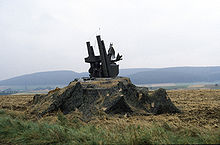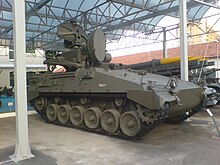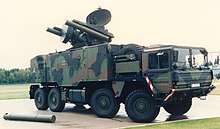
An armoured fighting vehicle or armored fighting vehicle (AFV) is an armed combat vehicle protected by armour, generally combining operational mobility with offensive and defensive capabilities. AFVs can be wheeled or tracked. Examples of AFVs are tanks, armoured cars, assault guns, self-propelled artilleries, infantry fighting vehicles (IFV), and armoured personnel carriers (APC).

An anti-aircraft vehicle, also known as a self-propelled anti-aircraft gun (SPAAG) or self-propelled air defense system (SPAD), is a mobile vehicle with a dedicated anti-aircraft capability.

The MIM-104 Patriot is a surface-to-air missile (SAM) system, the primary such system used by the United States Army and several allied states. It is manufactured by the U.S. defense contractor Raytheon and derives its name from the radar component of the weapon system. The AN/MPQ-53 at the heart of the system is known as the "Phased Array Tracking Radar to Intercept on Target," which is a backronym for "Patriot". In 1984, the Patriot system began to replace the Nike Hercules system as the U.S. Army's primary high to medium air defense (HIMAD) system and the MIM-23 Hawk system as the U.S. Army's medium tactical air defense system. In addition to these roles, Patriot has been given a function in the U.S. Army's anti-ballistic missile (ABM) system. As of 2016, the system is expected to stay fielded until at least 2040.

Rapier is a surface-to-air missile developed for the British Army to replace their towed Bofors 40/L70 anti-aircraft guns. The system is unusual as it uses a manual optical guidance system, sending guidance commands to the missile in flight over a radio link. This results in a high level of accuracy, therefore a large warhead is not required.

The Missile Transportable Anti-aérien Léger, commonly called Mistral, is a French infrared homing short range air defense system manufactured by MBDA France. Based on the French SATCP, the development of the portable system later to become the Mistral began in 1974. The first version of the system was introduced in 1988 (S1), the second in 1997, and the third in 2018.

The Oerlikon/Martin Marietta air defense anti-tank system is a dual-purpose short range surface-to-air and anti-tank missile system based on the M113A2 vehicle. The ADATS missile is a laser-guided supersonic missile with a range of 10 kilometers, with an electro-optical sensor with TV and forward looking infrared (FLIR). The carrying vehicle also has a search radar with an effective range of over 25 kilometers.

The AMX-30 is a main battle tank designed by Ateliers de construction d'Issy-les-Moulineaux and first delivered to the French Army in August 1966. The first five tanks were issued to the 501st Régiment de Chars de Combat in August of that year. The production version of the AMX-30B weighed 36 metric tons, and sacrificed protection for increased mobility. The French believed that it would have required too much armour to protect against the latest anti-tank threats, thereby reducing the tank's maneuverability. Protection, instead, was provided by the speed and the compact dimensions of the vehicle, including a height of 2.28 metres. It had a 105 mm gun, firing a then advanced high-explosive anti-tank (HEAT) warhead known as the Obus G. The Obus G used an outer shell, separated from the main charge by ball bearings, to allow the round to be spin stabilized by the gun without spinning the warhead inside which would disrupt jet formation. Mobility was provided by the 720 horsepower (540 kW) HS-110 diesel engine, although the troublesome transmission adversely affected the tank's performance.

The Avenger Air Defense System, designated AN/TWQ-1 under the Joint Electronics Type Designation System, is an American self-propelled surface-to-air missile system which provides mobile, short-range air defense protection for ground units against cruise missiles, unmanned aerial vehicles, low-flying fixed-wing aircraft, and helicopters.

The 2K12 "Kub" mobile surface-to-air missile system is a Soviet low to medium-level air defence system designed to protect ground forces from air attack. 2К12 is the GRAU designation of the system.
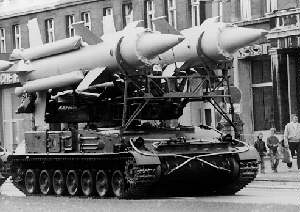
A transporter erector launcher (TEL) is a missile vehicle with an integrated tractor unit that can transport, elevate to a firing position and launch one or more rockets or missiles.

The 9K33 Osa is a highly mobile, low-altitude, short-range tactical surface-to-air missile system developed in the Soviet Union in the 1960s and fielded in 1972. Its export version name is Romb.

The Crotale is a French, all-weather, short-range surface-to-air missile system developed to intercept airborne ranged weapons and aircraft, from cruise or anti-ship missiles to helicopters, UAVs or low-flying high-performance fighter aircraft. It was developed by Thomson CSF Matra and consists of a mobile land-based variant as well as various naval ones.

The Raytheon MIM-23 HAWK is an American medium-range surface-to-air missile. It was designed to be a much more mobile counterpart to the MIM-14 Nike Hercules, trading off range and altitude capability for a much smaller size and weight. Its low-level performance was greatly improved over Nike through the adoption of new radars and a continuous wave semi-active radar homing guidance system. It entered service with the US Army in 1959.

The HOT is a second-generation long-range anti-tank missile system. It was originally developed to replace the older SS.11 wire guided missile in French and West German service. The design was a collaboration between the German firm Bölkow and the French firm Nord. Bölkow and Nord later merged into MBB and Aérospatiale respectively, both of which then formed Euromissile to design and produce the MILAN, Roland and HOT. This ultimately became part of MBDA.

The MIM-72A/M48 Chaparral is an American-made self-propelled surface-to-air missile system based on the AIM-9 Sidewinder air-to-air missile system. The launcher is based on the M113 family of vehicles. It entered service with the United States Army in 1969 and was phased out between 1990 and 1998. It was intended to be used along with the M163 VADS, the Vulcan ADS covering short-range short-time engagements, and the Chaparral for longer range use.

The AMX-10P is a French amphibious infantry fighting vehicle. It was developed from 1965 onwards to replace the AMX-VCI in the French Army. It served with the French Army from its introduction in 1973 until its retirement in 2015, when it was fully replaced by the VBCI.

The Pantsir missile system is a family of self-propelled, medium-range surface-to-air missile and anti-aircraft artillery systems. Three types of vehicles make up one system: a missile launcher, a radar truck and a command post. Starting with the Pantsir-S1 as the first version, it is produced by KBP Instrument Design Bureau of Tula, Russia, and is the successor to the Tunguska M1.
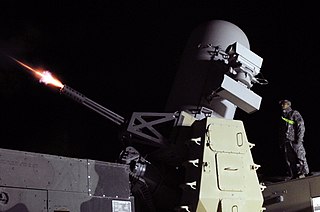
Counter rocket, artillery, and mortar, abbreviated C-RAM or counter-RAM, is a set of systems used to detect and/or destroy incoming rockets, artillery, and mortars before they hit their targets, or provide early warning.

A missile vehicle, also known as a missile carrier, missile truck, or missile launcher vehicle, is a military vehicle that is purpose-built and designed to carry missiles, either for safe transportation or for launching missiles in combat. Missile vehicles include transporter erector launchers (TEL) and multiple rocket launchers (MRL).

PSR-A Pilica is a Polish Very Short Range Air Defense (VSHORAD) anti-aircraft missile and artillery system.



